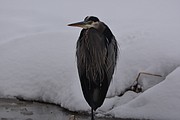Brrr... irds! How our feathered friends adapt in the winter
Some North Idahoans dread winter and, if they have the time and the means, will travel to warmer parts of the country to wait it out. Others enjoy the cold temperatures and can’t wait for the first snow. Most just adapt to the season, adding layers to keep them warm or staying indoors in front of a warm fire. Birds, it turns out, also face the winter season similarly.
Many birds do leave the Northwest to winter in the tropical regions of Mexico, Central America, South America and the Caribbean. But plenty of birds remain here year round.
Look outside on a blustery winter day and you’ll still see songbirds flitting at feeders and ducks swimming in icy creeks and in the Kootenai or Moyie River. How do they do it?
Birds, like mammals, are warm-blooded, meaning they must maintain a constant body temperature as the temperature around them changes. To do this, they spend much of their time feeding so they can generate enough heat. Meat-eating birds, like hawks and owls, may stay put if enough prey is available.
Birds that can switch from a primarily insect diet to a seed diet can stay put throughout the winter. But the availability of food is not enough. To survive severe weather, birds have developed adaptations.
One feature that sets birds apart from other animals is feathers. Birds’ bodies are covered with an outer layer of fairly stiff but flexible contour feathers and an under layer of fluffy down feathers. The contour feathers provide protection against wind, rain and snow. The down feathers act as a layer of insulation.
Tightly knit together and overlapping, feathers protect the skin and hold a layer of air over the bird’s body. Because birds control the position of their feathers through muscular movements, they are able to “puff” themselves up. By adjusting their feathers, birds create and trap larger pockets of warm air near their skin, enhancing insulation.
Many birds have an oil gland located at the base of their tail. Secreted oil is rubbed over the feathers with the beak or bill. This is known as preening. Preening creates a shield that helps block wind and repel water. Ducks, geese and swans can survive in water that is close to freezing because the amount of oil in their feathers makes them waterproof. Waterfowl and other water-birds also have a layer of fat that keeps them warm.
Anyone who has ever gone outside on a cold, windy day without a hat knows that uncovered body parts lose heat quickly. The same is true for birds. But they can adjust to this in several ways. Often birds will stand on one leg, tucking the other up among their feathers. Birds are also observed with their beaks tucked under their feathers. Smaller birds often drop on the ground to cover both legs with their fluffed up bodies.
Winter songbirds, water-birds and waterfowl are often the only types of wildlife easily seen and enjoyed this time of year. Just imagine how dull the landscape would be without these bright and hardy souls.
Enjoy Boundary County this winter and all our feathered friends.



